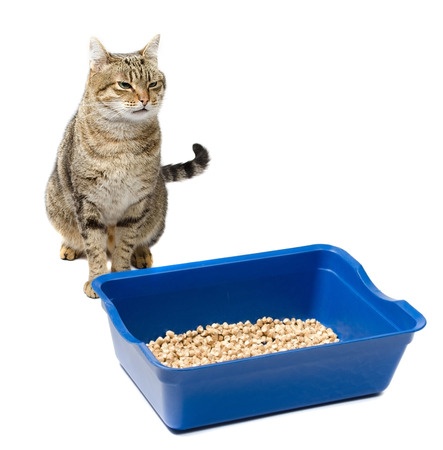Cat Box Trouble, IAE, Behavioral
Sometimes a cat will start urinating outside the litterpan. Sometimes it will urinate *and* defecate outside the pan. There can be numerous reasons for this unpalatable behavior. Read on…
Step One: Have a urine sample checked for red blood cells, white blood cells and bacteria. The sample could be collected by your vet with a needle. There should be few red and white cells and there should be about an even number of each. In other words, we would expect
RBC – 0-1 WBC – 0-1 Bacteria – few
If she has a urinary tract infection, this could explain the problem.
*HOWEVER*
Alot of cats have a behavioral disorder.
If she urinates outside the pail in the same place over and over, that’s pretty easy:
* Disinfect and deodorize that location.
* Put a small food and water bowl in the location, and
* *MAKE SURE HER REAL FOOD AND WATER BOWL ARE NOT IN THE SAME ROOM AS HER LITTER PAN*. The principle is that most cats resent doing their business anywhere near food or water. So we can repel her from the offense site, and allow her to comfortably use her litter pan because her food and water were removed from that room.
If she urinates always on *carpet*, she may have a carpet preference, and in this case, you should buy three more pans and put a scrap of carpet in them. Place these in the locations she normally urinates, instead of having her go on the walls.
Replace the carpet as needed. She won’t care if it’s a tacky color or a low grade berber.
Alot of cats hate *covered* pans. They feel uneasy about the fact that the covered pan has only *one exit*, and so some cats do not go inside, they feel claustrophobic. (They told me this). Uncover that pan as your first step.
Finally, sometimes cats can be attracted back to the pan with a novel litter. Sand, Peat Moss, Sphagnum moss, vermiculite or Black topsoil can feel so good to their feet and smell so *new* to their noses that they cannot resist! It doesn’t do alot for odor and may be higher maintenance, but the alternative is new carpet annually! That method is cheap. Try it.
If all of the above fail to curb the behavior, we have success with three medical treatments. Diazepam (Valium) Buspirone, and (if still available) Depo Provera.
Valium reduces the cat’s anxiety and dosed daily or twice daily, it can stop the behavior in 60% of cats. When the Valium stops (2-3 weeks later) the cat often has forgotten what it was peeved about to begin with.
Buspirone is also anxiolytic and works quite well, stopping about 60-75% of cats.
In cats for which these two medicines did not work, Depo Provera® can work wonderfully. An injection of 50-100 mg IM (do not give Sub Cutaneously) will often (50-60%) stop the behavior and is my preference because the medicine does not have to be dosed in pill form. (Easier for you).
A few rare cats will become so tranquil on the Depo Provera® that they will not elect to walk to get food. You have to bring their food to them, and they will thoughtfully, dreamily eat . That is a rare reaction. A few cats will not respond in any way to the medicine. Dosed often, Depo Provera® can result in Diabetes in cats, as well as some other blood and liver disorders. Let’s hope that one shot is all it would take.






